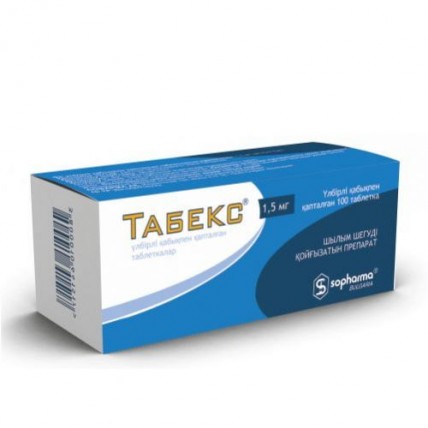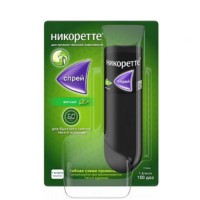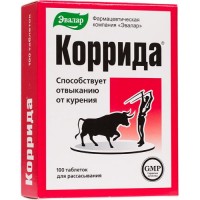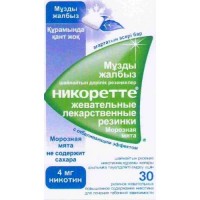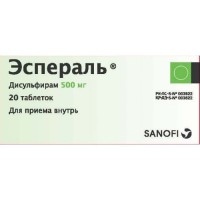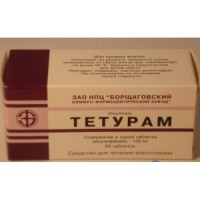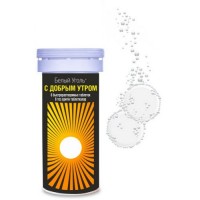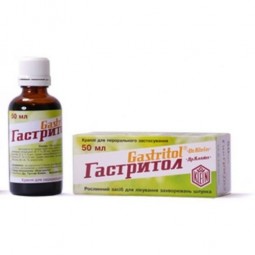TABEX® (Cytisine) 1.5 mg, 100 tablets
- $54.40
One tablet contains
Cytisine is readily absorbed from the gastrointestinal tract when taken orally.
The maximum plasma concentration, which is about 15.55 ng / ml, is reached within 0.92 hours.
Cytisine does not undergo significant metabolic transformation. 64% of the dose taken is excreted unchanged by the kidneys within 24 hours. The half-life is approximately 4 hours. The average retention time for cytisine is about 6 hours.
Cytisine is an alkaloid isolated from the plant Cytisus Laburnum.
Its chemical structure is similar to nicotine and lobelin. Selectively and competitively binds to n-cholinoneuroreceptors, blocks the ability to connect to these nicotine receptors, thus showing the properties of a nicotine antagonist. As a result of the action of these drugs, nicotine loses its ability to stimulate n-cholinergic receptors and activate the dopamine system - the mechanism that underlies the formation of tobacco dependence (enjoyment from nicotine). As a result of this action, the symptoms of nicotine addiction gradually decrease and disappear. Other pharmacodynamic properties of cytisine: excites the ganglia of the autonomic nervous system, reflexively excites respiration, causes the release of adrenaline from the medullary part of the adrenal gland, increases anterior pressure.
Chronic nicotinism (tobacco) - to quit smoking.
Dosage
adults
The drug is used according to the following scheme:
from 1 to 3 days - 1 tablet every 2 hours (6 tablets per day). During these days, a gradual decrease in the number of cigarettes smoked is expected. If the result is unsatisfactory, the treatment is stopped and after 2-3 months you can start it again. With a good impact, treatment continues as follows:
from 4 to 12 days - 1 tablet every 2.5 hours (5 tablets per day);
from 13 to 16 days - 1 tablet every 3 hours (4 tablets per day);
from 17 to 20 days - 1 tablet every 5 hours (3 tablets per day);
from 21 to 25 days - 1-2 tablets per day.
Pediatric population and patients over 65 years of age
The safety and efficacy of Tabex in children and adolescents under 18 years of age and in patients over 65 years of age have not been established.
Mode of application
Tablets are taken orally whole, washed down with a sufficient amount of liquid.
The final cessation of smoking should occur by the fifth day from the start of treatment. After completing the treatment course, the patient must show will and not allow himself to smoke a single cigarette.
The duration of treatment is according to the scheme.
Adverse reactions are presented by classes of organ systems and frequency. The frequency is presented as follows: very common (³ 1/10), frequent (³ 1/100 and <1/10), infrequent (³ 1/1000 and <1/100), rare (³ 1/10000 and < 1/1000), very rare (<1/10000), observed with unknown frequency (cannot be estimated from existing data).
Heart disorders
Frequency not known: tachycardia, palpitations
Vascular disorders
Not known: mild increase in blood pressure
Nervous System Disorders
Often
-headache*, dizziness*
Infrequently
- insomnia*, drowsiness*
Not known: irritability
Respiratory, thoracic and mediastinal disorders
With unknown frequency: dyspnea
Gastrointestinal disorders
Often
-pain in the upper abdomen*, nausea*, dry mouth*, dyspepsia*
Infrequently
-constipation*, diarrhea*, vomiting*
Not known: changes in taste and appetite, abdominal pain
Musculoskeletal and connective tissue disorders
Not known: myalgia
Metabolic and nutritional disorders
Not known: increased sweating, weight loss
General disorders and disorders at the injection site
Not known: chest pain
* Frequency calculated based on data from 5 randomized clinical trials.
Contraindications
- hypersensitivity to the active or any of the excipients
- acute myocardial infarction
- unstable angina
- Heart arythmy
- recent cerebrovascular accident
- atherosclerosis
- severe arterial hypertension
- pregnancy and breastfeeding period
- pulmonary edema
- peptic ulcer of the stomach and duodenum
When smoking, an increase in CYP1A2 activity is observed. After smoking cessation, the activity of this isoenzyme may be reduced, which may cause an increase in plasma concentrations of drugs that are metabolized with the participation of CYP1A2, such as theophylline, ropinirole, clozapine and olanzapine. In these cases, their side effects may increase, since these drugs have a small therapeutic breadth.
With the simultaneous use of Tabex® with cholinomimetics, including anticholinesterase drugs, cholinomimetic side effects may increase.
Simultaneous use with antihyperlipidemic drugs (statins) increases the risk of myalgia.
The simultaneous use of Tabex® with antihypertensive drugs may weaken their effect.
Tabex® should only be prescribed when the patient has a serious intention to quit smoking. Treatment with the drug and continued smoking can lead to an increase in the side effects of nicotine (nicotine intoxication).
There is not enough clinical experience with the use of Tabex® in patients with other forms of coronary heart disease, heart failure, arterial hypertension, cerebrovascular disease, obliterating arterial diseases, hyperthyroidism, peptic ulcer, diabetes mellitus, renal or hepatic insufficiency. The use of Tabex® in these patients should occur after careful evaluation by the attending physician.
Due to the lack of safety studies of the drug in patients with some forms of schizophrenia, patients with adrenal chromaffin tumors and gastroesophageal reflux disease, the use of cytisine in such cases should be after a thorough assessment of the benefit / risk ratio.
There is not enough clinical experience regarding the safe use of Tabex® in children under 18 years of age and in adults over 65 years of age, as a result of which its use in these age groups is not recommended.
The medicinal product contains the excipient lactose. Patients with rare hereditary problems of galactose intolerance, the Lapp lactase deficiency or glucose-galactose malabsorption should not use the drug.
Features of the influence of the drug on the ability to drive a vehicle or potentially dangerous mechanisms
Tabex® does not affect the ability to drive vehicles and work with machines.
Symptoms: nausea, vomiting, profuse sweating, tremor, blurred vision, general weakness, tachycardia, clonic convulsions, respiratory paralysis.
Treatment: gastric lavage if the patient is conscious, infusion therapy with saline solutions. Treatment is symptomatic, with the use of drugs that affect convulsions, respiratory disorders and the cardiovascular system.
The parameters of respiration and the cardiovascular system are monitored.
Store in the original packaging to protect from moisture, at a temperature not exceeding 25°C.
Keep out of the reach of children!
Shelf life - 2 years
Do not take after the expiration date.
- Active ingredient - Cytisine (in terms of 100% substance)
- Excipients: lactose monohydrate, microcrystalline cellulose (type 102), talc, magnesium stearate.
Pharmacological properties
Cytisine is readily absorbed from the gastrointestinal tract when taken orally.
The maximum plasma concentration, which is about 15.55 ng / ml, is reached within 0.92 hours.
Cytisine does not undergo significant metabolic transformation. 64% of the dose taken is excreted unchanged by the kidneys within 24 hours. The half-life is approximately 4 hours. The average retention time for cytisine is about 6 hours.
Cytisine is an alkaloid isolated from the plant Cytisus Laburnum.
Its chemical structure is similar to nicotine and lobelin. Selectively and competitively binds to n-cholinoneuroreceptors, blocks the ability to connect to these nicotine receptors, thus showing the properties of a nicotine antagonist. As a result of the action of these drugs, nicotine loses its ability to stimulate n-cholinergic receptors and activate the dopamine system - the mechanism that underlies the formation of tobacco dependence (enjoyment from nicotine). As a result of this action, the symptoms of nicotine addiction gradually decrease and disappear. Other pharmacodynamic properties of cytisine: excites the ganglia of the autonomic nervous system, reflexively excites respiration, causes the release of adrenaline from the medullary part of the adrenal gland, increases anterior pressure.
Indications for use
Chronic nicotinism (tobacco) - to quit smoking.
Dosage and administration
Dosage
adults
The drug is used according to the following scheme:
from 1 to 3 days - 1 tablet every 2 hours (6 tablets per day). During these days, a gradual decrease in the number of cigarettes smoked is expected. If the result is unsatisfactory, the treatment is stopped and after 2-3 months you can start it again. With a good impact, treatment continues as follows:
from 4 to 12 days - 1 tablet every 2.5 hours (5 tablets per day);
from 13 to 16 days - 1 tablet every 3 hours (4 tablets per day);
from 17 to 20 days - 1 tablet every 5 hours (3 tablets per day);
from 21 to 25 days - 1-2 tablets per day.
Pediatric population and patients over 65 years of age
The safety and efficacy of Tabex in children and adolescents under 18 years of age and in patients over 65 years of age have not been established.
Mode of application
Tablets are taken orally whole, washed down with a sufficient amount of liquid.
The final cessation of smoking should occur by the fifth day from the start of treatment. After completing the treatment course, the patient must show will and not allow himself to smoke a single cigarette.
The duration of treatment is according to the scheme.
Side effects
Adverse reactions are presented by classes of organ systems and frequency. The frequency is presented as follows: very common (³ 1/10), frequent (³ 1/100 and <1/10), infrequent (³ 1/1000 and <1/100), rare (³ 1/10000 and < 1/1000), very rare (<1/10000), observed with unknown frequency (cannot be estimated from existing data).
Heart disorders
Frequency not known: tachycardia, palpitations
Vascular disorders
Not known: mild increase in blood pressure
Nervous System Disorders
Often
-headache*, dizziness*
Infrequently
- insomnia*, drowsiness*
Not known: irritability
Respiratory, thoracic and mediastinal disorders
With unknown frequency: dyspnea
Gastrointestinal disorders
Often
-pain in the upper abdomen*, nausea*, dry mouth*, dyspepsia*
Infrequently
-constipation*, diarrhea*, vomiting*
Not known: changes in taste and appetite, abdominal pain
Musculoskeletal and connective tissue disorders
Not known: myalgia
Metabolic and nutritional disorders
Not known: increased sweating, weight loss
General disorders and disorders at the injection site
Not known: chest pain
* Frequency calculated based on data from 5 randomized clinical trials.
Contraindications
- hypersensitivity to the active or any of the excipients
- acute myocardial infarction
- unstable angina
- Heart arythmy
- recent cerebrovascular accident
- atherosclerosis
- severe arterial hypertension
- pregnancy and breastfeeding period
- pulmonary edema
- peptic ulcer of the stomach and duodenum
Drug Interactions
When smoking, an increase in CYP1A2 activity is observed. After smoking cessation, the activity of this isoenzyme may be reduced, which may cause an increase in plasma concentrations of drugs that are metabolized with the participation of CYP1A2, such as theophylline, ropinirole, clozapine and olanzapine. In these cases, their side effects may increase, since these drugs have a small therapeutic breadth.
With the simultaneous use of Tabex® with cholinomimetics, including anticholinesterase drugs, cholinomimetic side effects may increase.
Simultaneous use with antihyperlipidemic drugs (statins) increases the risk of myalgia.
The simultaneous use of Tabex® with antihypertensive drugs may weaken their effect.
Special instructions
Tabex® should only be prescribed when the patient has a serious intention to quit smoking. Treatment with the drug and continued smoking can lead to an increase in the side effects of nicotine (nicotine intoxication).
There is not enough clinical experience with the use of Tabex® in patients with other forms of coronary heart disease, heart failure, arterial hypertension, cerebrovascular disease, obliterating arterial diseases, hyperthyroidism, peptic ulcer, diabetes mellitus, renal or hepatic insufficiency. The use of Tabex® in these patients should occur after careful evaluation by the attending physician.
Due to the lack of safety studies of the drug in patients with some forms of schizophrenia, patients with adrenal chromaffin tumors and gastroesophageal reflux disease, the use of cytisine in such cases should be after a thorough assessment of the benefit / risk ratio.
There is not enough clinical experience regarding the safe use of Tabex® in children under 18 years of age and in adults over 65 years of age, as a result of which its use in these age groups is not recommended.
The medicinal product contains the excipient lactose. Patients with rare hereditary problems of galactose intolerance, the Lapp lactase deficiency or glucose-galactose malabsorption should not use the drug.
Features of the influence of the drug on the ability to drive a vehicle or potentially dangerous mechanisms
Tabex® does not affect the ability to drive vehicles and work with machines.
Overdose
Symptoms: nausea, vomiting, profuse sweating, tremor, blurred vision, general weakness, tachycardia, clonic convulsions, respiratory paralysis.
Treatment: gastric lavage if the patient is conscious, infusion therapy with saline solutions. Treatment is symptomatic, with the use of drugs that affect convulsions, respiratory disorders and the cardiovascular system.
The parameters of respiration and the cardiovascular system are monitored.
Storage conditions
Store in the original packaging to protect from moisture, at a temperature not exceeding 25°C.
Keep out of the reach of children!
Shelf life - 2 years
Do not take after the expiration date.
